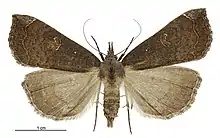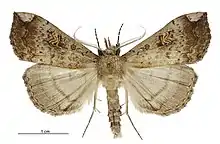Rhapsa scotosialis
Rhapsa scotosialis, the slender owlet moth, is a moth of the family Noctuidae. R. scotosialis is one of the most common forest moths found in New Zealand.[3]
| Rhapsa scotosialis | |
|---|---|
 | |
| Female | |
 | |
| Male | |
| Scientific classification | |
| Kingdom: | |
| Phylum: | |
| Class: | |
| Order: | |
| Family: | |
| Genus: | |
| Species: | R. scotosialis |
| Binomial name | |
| Rhapsa scotosialis | |
| Synonyms[2] | |
| |
Taxonomy
This species was first described by Francis Walker in 1866 from specimens collected in Auckland.[4] It was also described by Arthur Gardiner Butler in 1877 using the name Herminia lilacina.[5] This name was subsequently synonymised by Edward Meyrick in 1887.[2][6]
Description
The adults of this species were described by George Hudson as follows:
The expansion of the wings is 1 3/8 inches. The fore-wings have the costa considerably arched towards the apex, and the termen is bowed outwards in the middle; the colour is pale brown in the male and dark brown in the female; there are several obscure black marks near the base; the orbicular is very small, orange or pale grey outlined in black, the claviform is absent, the reniform is conspicuous, the outer edge is much indented, the inner edge is outlined with dull orange-red, there is a black blotch between the orbicular and the reniform; beyond the reniform there is a carved transverse line enveloping a series of minute black dots, then a very conspicuous wavy transverse line shaded towards the base of the wing; there is a pale triangular area at the apex, and a series of small crescentic dark brown markings on the termen; the cilia are dark brown. The hind-wings are greyish-ochreous; there is a rather faint line across the middle, followed by a broad shade; a series of small crescentic marks is situated on the termen; the cilia are dark greyish-ochreous. The antenna of the male are strongly bipectinated. The female is considerably darker, the markings are less distinct and numerous, and there is no black blotch between the orbicular and the reniform.[7]
Life stages
The eggs of R. scotosialis are bright green when freshly laid and turn a dull purple colour after a couple of days.[7] The caterpillar has a brown head and a white body. Each segment of the body of the caterpillar has a small round protuberance from which come a tuft of hairs.[7]
Host species
The host species for the larvae of R. scotosialis is Piper excelsum.[7]
References
- "Rhapsa scotosialis Walker, 1866". New Zealand Organisms Register. Landcare Research New Zealand. Retrieved 13 July 2017.
- Dugdale, J. S. "Lepidoptera — annotated catalogue, and keys to family-group taxa" (PDF). Fauna of New Zealand. 14: 211. Retrieved 13 July 2017.
- "Moth (Slender Owlet) Rhapsa scotosialis". Taranaki Educational Resource: Research, Analysis and Information Network. Retrieved 9 June 2012.
- Walker, Francis (1866). "XXXIV: Supplement - part 4". List of the Specimens of Lepidopterous Insects in the Collection of the British Museum. 34: 1121–1533 – via Biodiversity Heritage Library.
- Butler, A. G. (1877). "On two collections of heterocerous Lepidoptera from New Zealand, with descriptions of new genera and species". Proceedings of the Zoological Society of London. 1877: 379–407 – via Biodiversity Heritage Library.
- Meyrick, E. (1887). "Monograph of the New Zealand Noctuina". Transactions and Proceedings of the New Zealand Institute. 19: 3–40 – via Biodiversity Heritage Library.
- Hudson, G. V. (1898). New Zealand Moths and Butterflies (Macro-lepidoptera). London: West, Newman & co. pp. 36–37. doi:10.5962/bhl.title.32466. OCLC 727236768.
- Hoare, Robert J. B. (2014). A Photographic Guide to Moths & Butterflies of New Zealand. Ball, Olivier. Auckland: New Holland Publishers (NZ) Ltd. ISBN 9781869663995. OCLC 891672034.
![]() This article incorporates text from a publication now in the public domain: Hudson, George Vernon (1898). New Zealand Moths and Butterflies (Macro-lepidoptera).
This article incorporates text from a publication now in the public domain: Hudson, George Vernon (1898). New Zealand Moths and Butterflies (Macro-lepidoptera).
External links
| Wikimedia Commons has media related to Rhapsa scotosialis. |
- "Slender Owlet Moth (Rhapsa scotosialis)". iNaturalist. Citizen science observations.